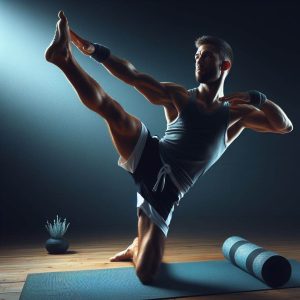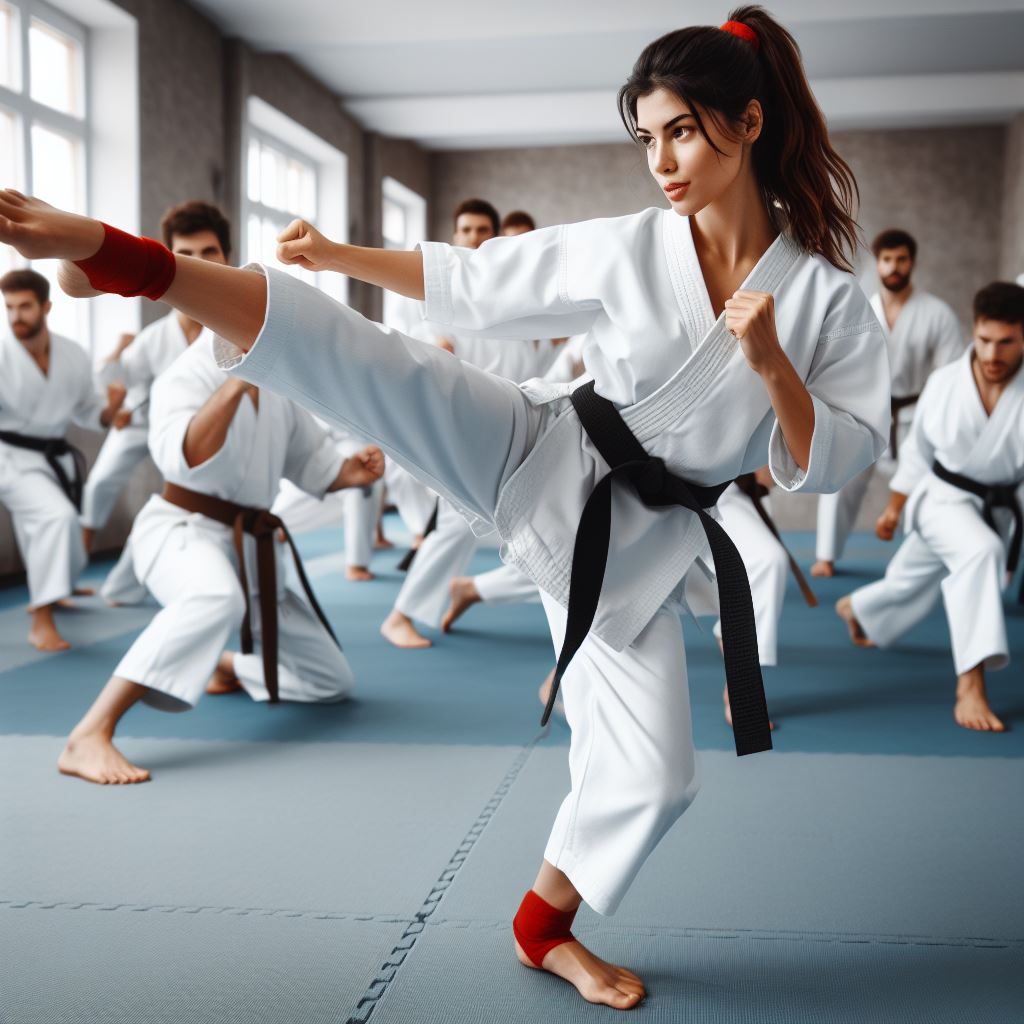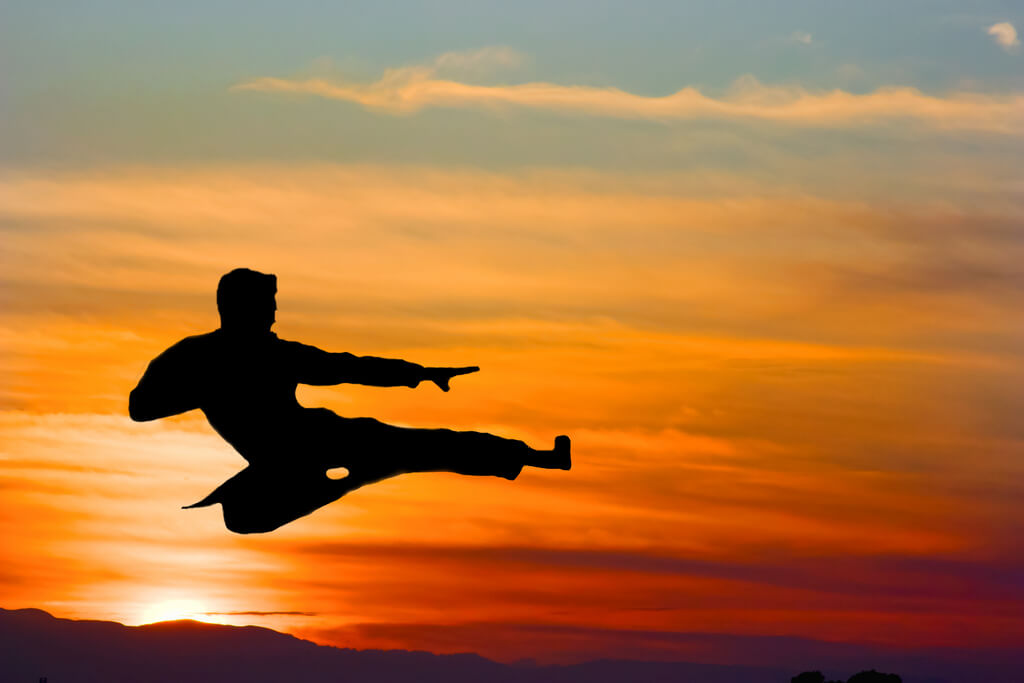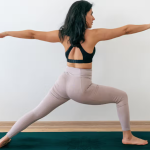IT FELT STRANGE TO WRITE ‘A FIGHTERS TAKE ON YOGA’ IN THE TITLE FOR THIS ARTICLE, BECAUSE THEY FEEL LIKE TWO OPPOSING FORCES. HOW COULD THEY POSSIBLY GO TOGETHER? IT TURNS OUT, THEY ACTUALLY GO HAND IN HAND!
YOGA IN COMBAT
Karate (meaning open handed) dates back to the Shaolin monks of 6th century China. The monks were secluded upon their mountain tops, but had no protection from potential attackers. To solve this problem, they studied Shaolin Kung Fu. It turns out that Kung Fu was not simply a method of security, but also a moving meditation much like yoga. The monks then split their days practising the zen-like movements of Kung Fu and meditating. The martial arts studio (dojo) was their yoga mat. Seeing the connection yet?
Fast forward a couple thousand years and Kung Fu is alive and well. I’ve been doing martial arts for around thirteen years, and have personally discovered the similarities between it and yoga. One thing I learned was that unlike the monks who learned martial arts as a way to protect themselves, modern martial artists are missing one crucial piece: the meditation.
I realised I lost that original moving meditation aspect one day as I was practising my forms and going through drills. I got so caught up in movement and precision that I forgot to just relax. That’s where the yoga comes in. Borrowing from the concept of moving meditation, I found a new sense of calmness in class. This calmness meant I was better mentally prepared for tournaments and sparring. This ‘zen’ feeling allowed me to gain more flexibility, and I found my kicks became higher and stronger than they’d ever been before.
THE QUEEN OF MEAN ON YOGA
Miriam “The Queen of Mean” Nakamoto is a Muay Thai world title holder who discovered yoga during her training. I got the chance to interview her at her home training gym: Combat Sports Academy in Dublin, California, where her pictures and belts adorn the walls. Miriam injured her knee in a Mixed Martial Arts fight in 2013 during a takedown from her opponent, and has since been in recovery using yoga as a contributing factor to her healing process.

“What is your background and how long have you been fighting?”
MN: I have been training for 15 years and fighting for 10. I have eight world titles and am 16 wins-0 losses in Muay Thai. In December 2013, I had an auto-grafted patella tendon surgery which is a reconstructive surgery on the knee and anterior cruciate ligament (ACL).
“How did you come across yoga?”
MN: In 2013 before my injury, I took class for only 2 weeks while getting ready for a fight. I really felt my hips really open up. I ended up winning that fight.
“How long have you been practising now?”
MN: I dabbled in yoga 5-7 years ago off and on. But a month consistently now.
“Why did you choose yoga?”
MN: Coming back from an injury that required surgery, I thought it would help bring my body back, allow me to safely come back from my injury. I also noticed that in my late 30’s, things started to hurt a bit more after time off and I don’t want any more injuries. I also want to improve my flexibility and overall well-being and I thought yoga would be the perfect choice.
“What style do you practice and what do you like about your teachers?”
MN: Iyengar and Vinyasa Flow. I really have been connecting with the teachers. Marilyn (Iyengar) is firm and pushes you out of your box just a little. While Jessica (Vinyasa Flow) is very accepting and encourages you to not push too hard. I always leave her class feeling very good. Coming from a very competitive nature, yoga is the total opposite. It’s so not competitive and I move from a state of competition to a state of feeling and being. I feel a lot less insecure, a feeling of being enough rather than not being good enough.
“Have you started to notice a difference in your body?”
MN: My hips opened up after 14 years of kicking. Butterfly Pose is finally comfortable to sit in. While holding a position, I notice different stages: emotionally, physically, and mentally. I move through the emotions of not feeling safe and secure to balance, finding my center, and calmness. I move through a myriad of emotions and mental states to re-find myself during the process and healing from this injury.
MIRIAM IN PRACTICE

Miriam observed while we were chatting that “you can win a lot of titles being insecure and using toughness.” Through yoga she has begun to experience a vulnerability and openness. About a month ago I had brought in my Dharma Yoga Wheel for my clients and co-workers to play on and she was eager to try it out. Miriam started to use the wheel, and as she moved into a back bend she became overwhelmed and flooded with emotions. Back bends can be quite a vulnerable action since they open the chest revealing the heart, and as she opened up to the ceiling she started to cry.
This simple back bend reminded me how powerful yoga can be and the emotional affect it can have. A typical fighting stance is very guarded and curved inward, which is why yoga can help bring that balance to fighters. It may even make them more confident during their fights.
On my way out, I also had a brief chat with Miriam’s coach and the owner of Combat Sports Academy, Kirian Fitzgibbons, and he mentioned a lot of fighters hold back on taking a yoga class because it is so different from what they are used to. He thinks it’s important for yoga to have a presence in the academy to offer his fighters the balance and change of pace yoga can bring.
That’s just one fighter’s take on how yoga has changed her sport. Are you a fighter who does yoga? Or a yogi who’s never tried fighting? I’d love to know if you see any interplay between the two. If you’re interesting in finding out more about Miriam and her journey, check out her Wikipedia page!













